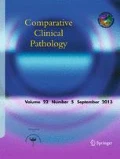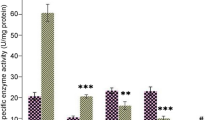Abstract
This study aimed to determine the trace elements and oxidative stress markers as contributory factors causing liver injury and erythrocyte destruction in sheep with liver cystic echinococcosis. In comparison to healthy control, the index of serum lipid peroxidation assessed by the malonyldialdehyde (MDA) level was significantly (P < 0.001) higher and the concentrations of serum total antioxidant status (TAS) and trace elements (zinc, copper, and iron) were significantly (P < 0.001) lower in sheep with liver cystic echinoccocosis. No significant differences were observed for erythrocyte glutathione peroxidase (GPx) and superoxide dismutase activities between infected and healthy groups. In infected sheep, a significant positive correlation of MDA with aspartate transaminase (AST) (r = 0.636, P = 0.000) and erythrocyte GPx (r = 0.373, P = 0.043) was observed. By contrast, serum MDA concentration was negatively correlated with the values of TAS (r = −0.559, P = 0.001) and packed cell volume (PCV; r = −0.473, P = 0.008). On the other hand, there was a significant negative correlation between serum TAS concentration and the levels of AST (r = −0.433, P = 0.017) and MDA (r = −0.559, P = 0.001). By contrast, serum TAS was positively correlated with the value of PCV (r = 0.728, P = 0.000). From the present study, it was concluded that cystic echinococcosis in sheep is associated with oxidative stress. The resulting oxidative stress seems to have a role in the injury of hepatocytes and erythrocytes.


Similar content being viewed by others
References
Abo-Shousha S, Khalil S, Rashman E (1999) Oxygen free radicals and nitric oxide production in single or combined human schistosomiasis and fascioliasis. J Egypt Soc Parasitol 29:149–156
Aruoma OI (1998) Free radicals, oxidative stress, and antioxidants in human health and disease. J Am Chem Soc 75:199
Boczon K, Hadas E, Wandurska-Nowak E, Derda M (1996) A stimulation of antioxidants in muscles of Trichinella spiralis infected rats. Acta Parasitologica 41:136–138
Clemens MR, Waller HD (1987) Lipid peroxidation in erythrocytes. Chem Phys Lipids 45:251–268
Deger Y, Ertekin A, Deger S, Mert H (2008) Lipid peroxidation and antioxidant potential of sheep liver infected naturally with distomatosis. Turkiye Parazitol Derg 32:23–26
Derda M, Wandurska-Nowak E, Hadas E (2004) Changes in the level of antioxidants in the blood from mice infected with Trichinella spiralis. Parasitol Res 93:207–210
Dimri U, Ranjan R, Kumar N, Sharma MC, Swarup D, Sharma B, Kataria M (2008) Changes in oxidative stress indices, zinc and copper concentrations in blood in canine demodicosis. Vet Parasitol 154:98–102
Dimri U, Sharma MC, Yamdagni A, Ranjan R, Zama MMS (2010) Psoroptic mange infestation increases oxidative stress and decreases antioxidant status in sheep. Vet Parasitol 168:318–322
Eckert E, Deplazes P (2004) Biological, epidemiological, and clinical aspects of echinococcosis, a zoonosis of increasing concern. Clin Microbiol Rev 17:107–135
Ergin S, Saribas S, Yuksel P, Zengin K, Midilli K, Adas G, Arikan S, Aslan M, Uysal H, Caliskan R, Oner A, Kucukbasmaci O, Kaygusuz A, Mamal Torun M, Kocazeybek B (2010) Genotypic characterisation of Echinococcus granulosus isolated from human in Turkey. Afr J Microbiol Res 4:551–555
Ersayit D, Kilic E, Yazar S, Artis T (2009) Oxidative stress in patients with cystic echninococcosis: relationship between oxidant and antioxidant parameters. Saglık Bil Dergisi 18:159–166
Evans P, Halliwell B (2001) Micronutrients: oxidant and antioxidant status. Br J Nutr 85:67–74
Fang YZ, Yang S, Wu G (2002) Free radicals, antioxidants and nutrition. Nutr 18:872–879
Galtier P, Cambon-Gros C, Fernandez Y, Deltour P, Eeckhoutte C, Hoellinger H (1994) Fasciola hepatica: liver microsomal membrane functions in host rat. Exp Parasitol 78:175–182
Gurer H, Ozgunes H, Neal R, Spitzand DR, Ercal N (1998) Antioxidant effects of N-acetyl cysteine and succimer in red blood cells from lead exposed rats. Toxicol 128:181–189
Gutteridge JMC (1995) Lipid peroxidation and antioxidants as biomarkers of tissue damage. Clin Chem 41:1819–1828
Halliwell B (1988) Albumin, an important extracellular antioxidant. Biochem Pharmacol 37:569–571
Halliwell B (1994) Free radicals, antioxidants, and human disease: curiosity, cause and consequence? Lancet 344:721–724
Halliwell B, Chirico S (1993) Lipid peroxidation: its mechanism, measurement, and significance. Am J Clin Nutr 57:715–725
Halliwell B, Gutteridge JMC (1999) Free radical biology and medicine, 3rd edn. Oxford University Press, Oxford
Jain NC (1986) Schalm's veterinary hematology, 4th edn. Lea & Febiger, Philadelphia
Kilic E, Yazar S, Baskol G, Artis T, Ersayit D (2010) Antioxidant and nitric oxide status in patients diagnosed with Echinococcus granulosus. Afr J Microbiol Res 4:2439–2443
Klasing KC (1988) Nutritional aspects of leukocytic cytokines. J Nutr 118:1436–1446
Kolodziejczyk L, Siemieniuk E, Skrzydlewska E (2005) Antioxidant potential of rat liver in experimental infection with Fasciola hepatica. Parasitol Res 96:367–372
Koltas IS, Yucebiligc G, Biligin R, Parsak CK, Sakman G (2006) serum malondialdehyde level in patients with cystic echinococcosis. Saudi Med J 27:1703–1705
Kosecik M, Erel O, Sevinc E, Selek S (2005) Increased oxidative stress in children exposed to passive smoking. Int J Cardiol 100:61–64
Latif AA, Tanveer A, Maqbool A, Siddiqi N, Kyaw-Tanner M, Traub RJ (2010) Morphological and molecular characterisation of Echinococcus granulosus in livestock and humans in Punjab, Pakistan. Vet Parasitol 170:44–49
Lilic A, Dencic S, Pavlovic SZ, Blagojevic DP, Spasic MB, Stankovic NS, Saicic ZS (2007) Activity of antioxidative defense enzymes in the blood of patients with liver echinococcosis. Vojnosanit Pregl 64:235–240
Loban A, Kime R, Powers H (1997) Iron-binding antioxidant potential of plasma albumin. Clin Sci (Lond) 93:445–451
May JM, Qu ZC, Mendiratta S (1998) Protection and recycling of alfa-tocopherol in human erythrocytes by intracellular ascorbic acid. Arch Biochem Biophys 349:281–289
Munoz C, Rios E, Olivos J, Brunser O, Olivares M (2007) Iron, copper and immunocompetence. Br J Nutr 98:24–28
Oteiza PI, Olin KL, Fraga CG, Keen CL (1995) Zinc deficiency causes oxidative damage to proteins, lipids and DNA in rat testes. J Nutr 125:823–829
Panda D, Patra RC, Nandi S, Swarup D (2009) Oxidative stress indices in gastroenteritis in dogs with canine parvoviral infection. Res Vet Sci 86:36–42
Pednekar RP, Gatne ML, Thompson RCA, Traub RJ (2009) Molecular and morphological characterisation of Echinococcus from food producing animals in India. Vet Parasitol 165:58–65
Placer ZA, Cushman L, Johnson B (1966) Estimation of product of lipid peroxidation (malonyldialdehyde) in biochemical system. Anal Biochem 16:359–364
Rush JW, Sandiford SD (2003) Plasma glutathione peroxidase in healthy young adults: influence of gender and physical activity. Clin Biochem 36:345–351
Saleh MA (2008) Circulating oxidative stress status in desert sheep naturally infected with Fasciola hepatica. Vet Parasitol 154:262–269
Saleh MA, Al-Salahy MB, Sanousi SA (2009) Oxidative stress in blood of camels (Camelus dromedaries) naturally infected with Trypanosoma evansi. Vet Parasitol 162:192–199
Sanchez-Campos S, Tunon MJ, Gonzales P, Gonzales-Gallego J (1999) Oxidative stress and changes in liver antioxidant enzymes induced by experimental dicrocoeliosis in hamsters. Parasitol Res 85:468–474
Sato Y, Kanazawa S, Sato K, Suzuki Y (1998) Mechanism of free radical induced hemolysis of human erythrocytes: II. Hemolysis by lipid soluble radical initiator. Biol Pharm Bull 21:250–256
Seyrek K, Karagenc T, Pasa S, Kıral F, Atasoy A (2009) Serum zinc, iron and copper concentrations in dogs infected with Hepatozoon canis. Acta Vet Brno 78:471–475
Simsek S, Yuce A, Utuk AE (2006) Determination of serum malondialdehyde levels in sheep naturally infected with Dicrocoelium dendriticum. F U Saglık Bil Dergisi 20:217–220
Sobolewski P, Gramaglia I, Frangos J, Intaglietta M, van der Heyde HC (2005) Nitric oxide bioavailability in malaria. Trends Parasitol 21:415–422
Tasci S, Sengil AZ, Altindis M, Arisoy K (1995) The effect of zinc supplementation in experimentally induced Toxoplasma gandii infection. J Egypt Soc Parasitol 25:745–751
Wanger HM, Buesher HU, Rollinghoff M, Solbach W (1991) Interferon-gamma inhibits the efficacy of interleukin-1 to generate a Th2-cell biased immune response induced by Leishmania major. Immunobiology 182:292–306
Weinberg JB, Lopansri BK, Mwaikambo E, Granger DL (2008) Arginine, nitric oxide, carbon monoxide, and endothelial function in severe malaria. Curr Opin Infect Dis 21:468–475
Zaki MH, Akuta T, Akaike T (2005) Nitric oxide-induced nitrative stress involved in microbial pathogenesis. J Pharmacol Sci 98:117–129
Zeghir-Bouteldja R, Amri M, Aitaissa S, Bouaziz S, Mezioug D, Touil-Boukoffa C (2009) In vitro study of nitric oxide metabolites effects on human hydatid of Echinococcus granulosus. J Parasitol Res. doi:10.1155/2009/624919
Zelko IN, Mariani TJ, Folz RJ (2002) Superoxide dismutase multigene family. a comparison of the CuZn-SOD (SOD1), Mn-SOD (SOD2), and EC-SOD (SOD3) gene structures, evolution, and expression. Free Radic Biol Med 33:337–349
Acknowledgments
This study was supported by research fund of Ferdowsi University of Mashhad (project no. 17026/2). The authors wish to thank technicians who kindly helped us for sample collection of this study
Conflict of interest statement
The authors declare that they have no conflict of interest.
Author information
Authors and Affiliations
Corresponding author
Rights and permissions
About this article
Cite this article
Heidarpour, M., Mohri, M., Borji, H. et al. Oxidant/antioxidant balance and trace elements status in sheep with liver cystic echinococcosis. Comp Clin Pathol 22, 1043–1049 (2013). https://doi.org/10.1007/s00580-012-1523-5
Received:
Accepted:
Published:
Issue Date:
DOI: https://doi.org/10.1007/s00580-012-1523-5




